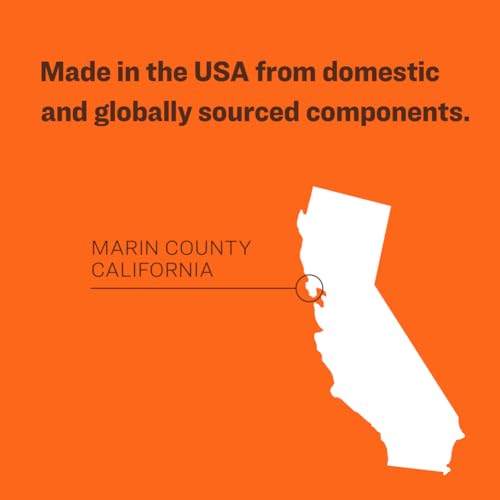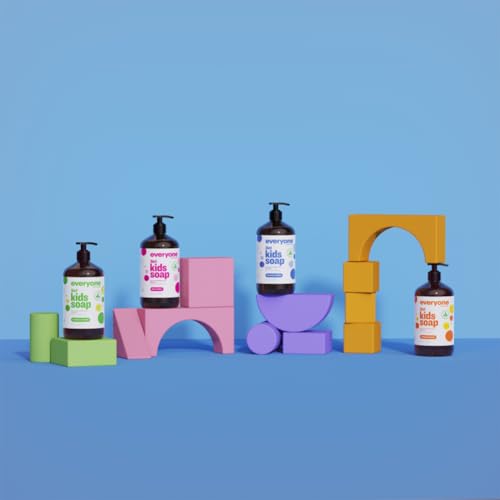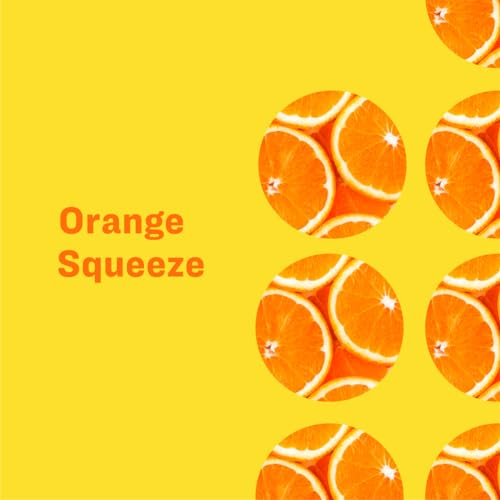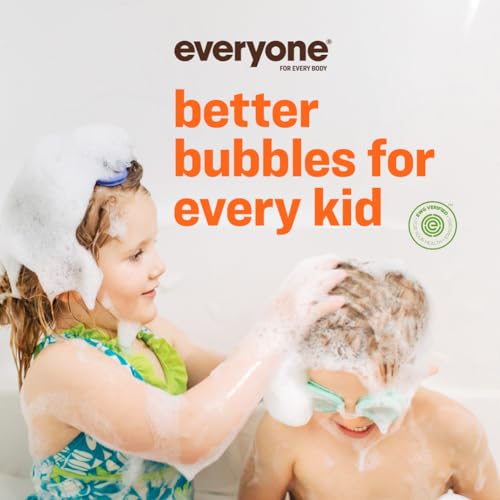






Everyone 3-in-1 Kids Body Wash - EWG Verified, Coconut Cleanser, Orange Squeeze Scent - 32oz


Benzyl Alcohol
High RiskBenzyl alcohol is a naturally occurring and synthetic aromatic alcohol commonly used as a solvent, preservative, and fragrance ingredient in various products. It is found in both plant sources and as a synthetic compound, functioning primarily to maintain product stability and enhance fragrance profiles.
Sustai Insights
Benzyl alcohol serves effectively as a preservative and solvent, contributing to product stability and sensory qualities. However, it poses potential health risks, particularly as an allergen, with high concern for immunotoxicity. Environmental risks include being a pollutant with low bioaccumulation potential. Regulatory agencies have established restrictions on its use in certain products. Overall, the risk level associated with benzyl alcohol is assessed as high, necessitating careful consideration of its use and potential alternatives.
Citric Acid
Medium RiskCitric acid is an alpha hydroxy acid used in personal care products primarily for its role as a pH adjuster and natural preservative. It occurs naturally in citrus fruits and is commonly utilized in various formulations for its chelating properties and mild exfoliation benefits.
Sustai Insights
Citric acid offers functional benefits as an effective preservative and pH stabilizer, contributing to product longevity and stability. It is biodegradable and derived from renewable sources. Health risks are low, with minimal concerns regarding carcinogenicity, allergies, and reproductive toxicity. However, moderate use restrictions exist due to potential irritation at high concentrations. Environmental risks are limited, as citric acid is not known to accumulate in ecosystems. Regulatory agencies have no significant advisories against its use. Overall, it is assessed as a medium-risk ingredient, with safe usage practices recommended and alternatives available.
Citrus Aurantium Dulcis (Orange) Peel Oil
Medium RiskCitrus aurantium dulcis (orange) peel oil is derived from the peel of oranges and is commonly used in cosmetic and personal care products for its fragrance and potential skin benefits. It is known for its aromatic properties and is often included in formulations aimed at enhancing scent profiles.
Sustai Insights
Citrus aurantium dulcis (orange) peel oil offers functional benefits such as providing a pleasant scent and potential antimicrobial properties. However, it poses a high allergy risk and may cause skin irritation in sensitive individuals. Environmental concerns include moderate persistence and potential to contribute to pollution. Regulatory warnings indicate restrictions on use in certain products. Overall, the risk level is assessed as medium, and users are advised to practice caution, particularly those with known allergies. Alternatives like sweet orange essential oil may provide similar benefits with potentially lower risks.
Unspecified Botanical Oil(s)
Medium RiskUnspecified botanical oils are natural extracts derived from various plant sources, commonly used in cosmetic and personal care products for their moisturizing, emollient, and fragrance properties. These oils can serve multiple functions, including enhancing product texture and providing skin benefits.
Sustai Insights
Unspecified botanical oils offer functional benefits such as moisturizing and emollient properties, contributing positively to product texture. Sustainability can be affirmed if sourced ethically. Health risks are low for carcinogenicity, allergies, and reproductive toxicity. Environmental concerns are minimal; however, regulatory bodies advise cautious use. Overall, the ingredient has a medium risk level, and users should consider alternatives like specific plant oils with established safety profiles.
Phenoxyethanol
Medium RiskPhenoxyethanol is a preservative used in cosmetics and personal care products to prevent microbial growth and extend shelf life. It is commonly found in formulations such as lotions, creams, and serums.
Sustai Insights
Phenoxyethanol serves effectively as a preservative, ensuring product stability and safety by inhibiting microbial growth. It is considered to have low health risks regarding carcinogenicity, allergies, and reproductive toxicity. However, moderate use restrictions exist, and regulatory bodies have advised caution in specific applications. Environmental concerns include its potential as a pollutant, although it is not highly bioaccumulative. Overall, the ingredient presents a medium risk level, with safe usage practices recommended and alternative preservatives available for those seeking greener options.
Tocopherol, D Alpha
Low RiskTocopherol, specifically d-alpha tocopherol, is a naturally occurring form of Vitamin E. It is commonly used in cosmetic and personal care products primarily for its antioxidant properties, helping to protect formulations from oxidation and extend shelf life.
Sustai Insights
D-alpha tocopherol provides effective antioxidant benefits, contributing to product stability. It is sustainably sourced and generally regarded as safe, with low concerns regarding carcinogenicity, allergies, and reproductive toxicity. However, there are minor concerns about endocrine disruption. Regulatory bodies have not imposed significant restrictions, indicating low overall risk. Recommended usage practices include adhering to established safe concentration thresholds. Alternatives, such as other forms of Vitamin E or plant-based antioxidants, may also be considered.
Cocamidopropyl Hydroxysultaine
Low RiskCocamidopropyl hydroxysultaine is a synthetic skin and hair conditioning agent commonly used in personal care products. It functions primarily as a surfactant, providing foaming and emulsifying properties, while also contributing to the conditioning of hair and skin.
Sustai Insights
Cocamidopropyl hydroxysultaine offers functional benefits as a mild surfactant and conditioning agent, with low concerns regarding carcinogenicity, allergies, and reproductive toxicity. It is generally regarded as safe with low irritation potential. Environmental assessments indicate low pollutant potential and minimal bioaccumulation. Regulatory bodies have not imposed significant restrictions on its use, aligning with low risk levels overall. Safe usage is advised, particularly for sensitive populations, and alternative gentle surfactants may be considered for those seeking greener options. In conclusion, this ingredient is classified as low risk.
Sodium
Low RiskSodium is a chemical element commonly used in various products, primarily as a preservative and stabilizing agent. It is involved in numerous reactions, contributing to the overall functionality and safety of formulations.
Sustai Insights
Sodium serves as an effective preservative, helping to extend product shelf life. It is generally recognized as safe with low concerns for carcinogenicity, allergies, and reproductive toxicity. However, excessive exposure may lead to health issues like hypertension. Environmentally, sodium is considered low risk regarding pollution and bioaccumulation. Regulatory bodies have not imposed significant restrictions on its use. Overall, the risk associated with sodium is low, making it a suitable ingredient with no major health or environmental concerns.
Chamomilla Recutita (Matricaria) Flower Extract
Low RiskChamomilla recutita (Matricaria) flower extract is derived from the flower of the chamomile plant. It is commonly used in cosmetic products for its soothing properties and as an anti-inflammatory agent. This extract is valued for its potential to calm skin irritations and enhance overall skin appearance.
Sustai Insights
Chamomilla recutita (Matricaria) flower extract is recognized for its soothing and anti-inflammatory benefits, making it effective in skincare formulations. It is sustainably sourced and not associated with significant health risks, such as carcinogenicity or allergenic potential, resulting in a low-risk profile. Environmental concerns are minimal as it does not contribute significantly to pollution. Regulatory bodies impose few restrictions on its use, further supporting its safety. However, users should practice standard safety measures, particularly if they have known sensitivities. Overall, it is a low-risk ingredient with favorable attributes.
Sodium Coco Sulfate
Low RiskSodium coco-sulfate is a sodium salt of the fatty acids derived from coconut oil. It primarily functions as a surfactant and cleansing agent in cosmetic formulations, helping to create lather and remove dirt and oils from the skin and hair.
Sustai Insights
Sodium coco-sulfate offers effective cleansing properties and is often considered biodegradable, contributing to its sustainability credentials. Health risks are minimal, with low concerns for carcinogenicity, allergies, and reproductive toxicity. Environmental risks are also low, excluding significant pollutant potential. Regulatory bodies have not issued major restrictions, confirming its safety for use. Overall, it is assessed with a low risk level. For those seeking alternatives, other milder surfactants like decyl glucoside may be considered.
Prunus Armeniaca (Apricot) Fruit
Low RiskPrunus armeniaca (apricot) fruit is the edible fruit of the apricot tree, commonly found in temperate regions. It is characterized by its soft, orange flesh and sweet flavor, often used in food products, cosmetics, and skin care formulations for its moisturizing properties.
Sustai Insights
Prunus armeniaca (apricot) fruit offers functional benefits such as moisturizing and nourishing skin, making it a valuable ingredient in cosmetic formulations. It is sustainably sourced and biodegradable. Known health risks are low, with minimal associations to carcinogenicity, allergies, or developmental toxicity. Environmental risks are also low, with no significant pollutant potential. Regulatory bodies do not impose restrictions on its use, affirming its safety. Overall, the ingredient presents a low risk profile and is suitable for various applications, with no significant concerns regarding exposure or alternatives.
Caprylyl/ Capryl Glucoside
Low RiskCaprylyl/capryl glucoside is an alkyl glucoside derived from natural sources, commonly used as a surfactant and emulsifier in personal care products. It aids in the cleansing and foaming properties of formulations, enhancing the overall texture and performance without harsh effects.
Sustai Insights
Caprylyl/capryl glucoside serves effectively as a mild surfactant, providing gentle cleansing and emulsification. It is biodegradable and derived from renewable sources, contributing to its sustainability profile. However, it may cause mild skin irritation in sensitive individuals, and while its allergenic potential is low to moderate, caution is advised. Regulatory status indicates no significant restrictions, and overall risk assessment suggests a low risk for health and environmental impacts, making it a favorable option in formulations.
Panthenol, D
Low RiskPanthenol, also known as provitamin B5, is a humectant commonly used in cosmetic and personal care products. It functions primarily as a moisturizer, enhancing skin hydration and improving the appearance of hair by imparting shine and softness.
Sustai Insights
Panthenol is effective in retaining moisture, thus providing functional benefits for skin and hair care products. It is generally recognized as safe, with low concerns regarding carcinogenicity, allergies, and developmental toxicity. However, potential cumulative exposure from multiple sources exists. Environmental risks are minimal, and it is not bioaccumulative. Regulatory bodies have not issued significant warnings; therefore, the overall risk level is assessed as low. For optimal use, it is recommended to follow product guidelines, and alternatives such as glycerin may also be considered for moisturizing effects.
Potassium
Low RiskPotassium is a naturally occurring mineral essential for various biological functions, including maintaining fluid balance, muscle contractions, and nerve signaling. It is commonly used in food and cosmetic products as a salt substitute and to enhance product stability.
Sustai Insights
Potassium has functional benefits such as supporting hydration and overall cellular function. It is generally recognized as safe, with low concerns regarding carcinogenicity, allergies, and reproductive toxicity. Environmental risks are minimal, as it does not significantly contribute to pollution. Regulatory bodies have not imposed restrictions on its use. Overall, potassium is assessed as low risk, with safe usage practices recommended for optimal benefits.
Tocopherol, D Alpha
Low RiskTocopherol, specifically d-alpha tocopherol, is a naturally occurring form of Vitamin E. It is commonly used in cosmetic and personal care products primarily for its antioxidant properties, helping to protect formulations from oxidation and extend shelf life.
Sustai Insights
D-alpha tocopherol provides effective antioxidant benefits, contributing to product stability. It is sustainably sourced and generally regarded as safe, with low concerns regarding carcinogenicity, allergies, and reproductive toxicity. However, there are minor concerns about endocrine disruption. Regulatory bodies have not imposed significant restrictions, indicating low overall risk. Recommended usage practices include adhering to established safe concentration thresholds. Alternatives, such as other forms of Vitamin E or plant-based antioxidants, may also be considered.
Cocamidopropyl Hydroxysultaine
Low RiskCocamidopropyl hydroxysultaine is a synthetic skin and hair conditioning agent commonly used in personal care products. It functions primarily as a surfactant, providing foaming and emulsifying properties, while also contributing to the conditioning of hair and skin.
Sustai Insights
Cocamidopropyl hydroxysultaine offers functional benefits as a mild surfactant and conditioning agent, with low concerns regarding carcinogenicity, allergies, and reproductive toxicity. It is generally regarded as safe with low irritation potential. Environmental assessments indicate low pollutant potential and minimal bioaccumulation. Regulatory bodies have not imposed significant restrictions on its use, aligning with low risk levels overall. Safe usage is advised, particularly for sensitive populations, and alternative gentle surfactants may be considered for those seeking greener options. In conclusion, this ingredient is classified as low risk.
Citric Acid
Medium RiskCitric acid is an alpha hydroxy acid used in personal care products primarily for its role as a pH adjuster and natural preservative. It occurs naturally in citrus fruits and is commonly utilized in various formulations for its chelating properties and mild exfoliation benefits.
Sustai Insights
Citric acid offers functional benefits as an effective preservative and pH stabilizer, contributing to product longevity and stability. It is biodegradable and derived from renewable sources. Health risks are low, with minimal concerns regarding carcinogenicity, allergies, and reproductive toxicity. However, moderate use restrictions exist due to potential irritation at high concentrations. Environmental risks are limited, as citric acid is not known to accumulate in ecosystems. Regulatory agencies have no significant advisories against its use. Overall, it is assessed as a medium-risk ingredient, with safe usage practices recommended and alternatives available.
Citrus Aurantium Dulcis (Orange) Peel Oil
Medium RiskCitrus aurantium dulcis (orange) peel oil is derived from the peel of oranges and is commonly used in cosmetic and personal care products for its fragrance and potential skin benefits. It is known for its aromatic properties and is often included in formulations aimed at enhancing scent profiles.
Sustai Insights
Citrus aurantium dulcis (orange) peel oil offers functional benefits such as providing a pleasant scent and potential antimicrobial properties. However, it poses a high allergy risk and may cause skin irritation in sensitive individuals. Environmental concerns include moderate persistence and potential to contribute to pollution. Regulatory warnings indicate restrictions on use in certain products. Overall, the risk level is assessed as medium, and users are advised to practice caution, particularly those with known allergies. Alternatives like sweet orange essential oil may provide similar benefits with potentially lower risks.
Benzyl Alcohol
High RiskBenzyl alcohol is a naturally occurring and synthetic aromatic alcohol commonly used as a solvent, preservative, and fragrance ingredient in various products. It is found in both plant sources and as a synthetic compound, functioning primarily to maintain product stability and enhance fragrance profiles.
Sustai Insights
Benzyl alcohol serves effectively as a preservative and solvent, contributing to product stability and sensory qualities. However, it poses potential health risks, particularly as an allergen, with high concern for immunotoxicity. Environmental risks include being a pollutant with low bioaccumulation potential. Regulatory agencies have established restrictions on its use in certain products. Overall, the risk level associated with benzyl alcohol is assessed as high, necessitating careful consideration of its use and potential alternatives.
Sodium
Low RiskSodium is a chemical element commonly used in various products, primarily as a preservative and stabilizing agent. It is involved in numerous reactions, contributing to the overall functionality and safety of formulations.
Sustai Insights
Sodium serves as an effective preservative, helping to extend product shelf life. It is generally recognized as safe with low concerns for carcinogenicity, allergies, and reproductive toxicity. However, excessive exposure may lead to health issues like hypertension. Environmentally, sodium is considered low risk regarding pollution and bioaccumulation. Regulatory bodies have not imposed significant restrictions on its use. Overall, the risk associated with sodium is low, making it a suitable ingredient with no major health or environmental concerns.
Unspecified Botanical Oil(s)
Medium RiskUnspecified botanical oils are natural extracts derived from various plant sources, commonly used in cosmetic and personal care products for their moisturizing, emollient, and fragrance properties. These oils can serve multiple functions, including enhancing product texture and providing skin benefits.
Sustai Insights
Unspecified botanical oils offer functional benefits such as moisturizing and emollient properties, contributing positively to product texture. Sustainability can be affirmed if sourced ethically. Health risks are low for carcinogenicity, allergies, and reproductive toxicity. Environmental concerns are minimal; however, regulatory bodies advise cautious use. Overall, the ingredient has a medium risk level, and users should consider alternatives like specific plant oils with established safety profiles.
Chamomilla Recutita (Matricaria) Flower Extract
Low RiskChamomilla recutita (Matricaria) flower extract is derived from the flower of the chamomile plant. It is commonly used in cosmetic products for its soothing properties and as an anti-inflammatory agent. This extract is valued for its potential to calm skin irritations and enhance overall skin appearance.
Sustai Insights
Chamomilla recutita (Matricaria) flower extract is recognized for its soothing and anti-inflammatory benefits, making it effective in skincare formulations. It is sustainably sourced and not associated with significant health risks, such as carcinogenicity or allergenic potential, resulting in a low-risk profile. Environmental concerns are minimal as it does not contribute significantly to pollution. Regulatory bodies impose few restrictions on its use, further supporting its safety. However, users should practice standard safety measures, particularly if they have known sensitivities. Overall, it is a low-risk ingredient with favorable attributes.
Sodium Coco Sulfate
Low RiskSodium coco-sulfate is a sodium salt of the fatty acids derived from coconut oil. It primarily functions as a surfactant and cleansing agent in cosmetic formulations, helping to create lather and remove dirt and oils from the skin and hair.
Sustai Insights
Sodium coco-sulfate offers effective cleansing properties and is often considered biodegradable, contributing to its sustainability credentials. Health risks are minimal, with low concerns for carcinogenicity, allergies, and reproductive toxicity. Environmental risks are also low, excluding significant pollutant potential. Regulatory bodies have not issued major restrictions, confirming its safety for use. Overall, it is assessed with a low risk level. For those seeking alternatives, other milder surfactants like decyl glucoside may be considered.
Prunus Armeniaca (Apricot) Fruit
Low RiskPrunus armeniaca (apricot) fruit is the edible fruit of the apricot tree, commonly found in temperate regions. It is characterized by its soft, orange flesh and sweet flavor, often used in food products, cosmetics, and skin care formulations for its moisturizing properties.
Sustai Insights
Prunus armeniaca (apricot) fruit offers functional benefits such as moisturizing and nourishing skin, making it a valuable ingredient in cosmetic formulations. It is sustainably sourced and biodegradable. Known health risks are low, with minimal associations to carcinogenicity, allergies, or developmental toxicity. Environmental risks are also low, with no significant pollutant potential. Regulatory bodies do not impose restrictions on its use, affirming its safety. Overall, the ingredient presents a low risk profile and is suitable for various applications, with no significant concerns regarding exposure or alternatives.
Phenoxyethanol
Medium RiskPhenoxyethanol is a preservative used in cosmetics and personal care products to prevent microbial growth and extend shelf life. It is commonly found in formulations such as lotions, creams, and serums.
Sustai Insights
Phenoxyethanol serves effectively as a preservative, ensuring product stability and safety by inhibiting microbial growth. It is considered to have low health risks regarding carcinogenicity, allergies, and reproductive toxicity. However, moderate use restrictions exist, and regulatory bodies have advised caution in specific applications. Environmental concerns include its potential as a pollutant, although it is not highly bioaccumulative. Overall, the ingredient presents a medium risk level, with safe usage practices recommended and alternative preservatives available for those seeking greener options.
Caprylyl/ Capryl Glucoside
Low RiskCaprylyl/capryl glucoside is an alkyl glucoside derived from natural sources, commonly used as a surfactant and emulsifier in personal care products. It aids in the cleansing and foaming properties of formulations, enhancing the overall texture and performance without harsh effects.
Sustai Insights
Caprylyl/capryl glucoside serves effectively as a mild surfactant, providing gentle cleansing and emulsification. It is biodegradable and derived from renewable sources, contributing to its sustainability profile. However, it may cause mild skin irritation in sensitive individuals, and while its allergenic potential is low to moderate, caution is advised. Regulatory status indicates no significant restrictions, and overall risk assessment suggests a low risk for health and environmental impacts, making it a favorable option in formulations.
Panthenol, D
Low RiskPanthenol, also known as provitamin B5, is a humectant commonly used in cosmetic and personal care products. It functions primarily as a moisturizer, enhancing skin hydration and improving the appearance of hair by imparting shine and softness.
Sustai Insights
Panthenol is effective in retaining moisture, thus providing functional benefits for skin and hair care products. It is generally recognized as safe, with low concerns regarding carcinogenicity, allergies, and developmental toxicity. However, potential cumulative exposure from multiple sources exists. Environmental risks are minimal, and it is not bioaccumulative. Regulatory bodies have not issued significant warnings; therefore, the overall risk level is assessed as low. For optimal use, it is recommended to follow product guidelines, and alternatives such as glycerin may also be considered for moisturizing effects.
Potassium
Low RiskPotassium is a naturally occurring mineral essential for various biological functions, including maintaining fluid balance, muscle contractions, and nerve signaling. It is commonly used in food and cosmetic products as a salt substitute and to enhance product stability.
Sustai Insights
Potassium has functional benefits such as supporting hydration and overall cellular function. It is generally recognized as safe, with low concerns regarding carcinogenicity, allergies, and reproductive toxicity. Environmental risks are minimal, as it does not significantly contribute to pollution. Regulatory bodies have not imposed restrictions on its use. Overall, potassium is assessed as low risk, with safe usage practices recommended for optimal benefits.
Discover Everyone 3-in-1 Kids Soap, a versatile 32-ounce body wash that transforms bath time into a vibrant adventure! This Orange Squeeze soap combines the uplifting scent of orange essential oil with calming lavender, making every wash enjoyable.
- All-in-One Cleanser: This zesty soap works as a shampoo, body wash, and bubble bath, simplifying bath time with just one bottle.
- Gentle Ingredients: Formulated with plant extracts and essential oils, it's perfect for sensitive skin and is free from harmful additives like parabens and synthetic fragrances.
- Eco-Friendly Packaging: Made from 100% recycled materials, the packaging supports a zero-waste mission, helping reduce landfill waste.
- EWG Verified: This product meets strict safety standards, ensuring a clean and safe bathing experience for children.
- Fun Bath Experience: The refreshing orange scent will delight kids, making them look forward to bath time instead of dreading it.
Subscribe & Save with Sustai
- Best Price Guarantee: Always enjoy the lowest prices on sustainable home essentials.
- No Surprises: We’ll notify you before shipping. No hidden fees, ever.
- You’re in Charge: Change, pause, or cancel your subscription anytime with ease.
- Eco-Friendly Deliveries: Our grouped shipments mean less packaging and lower emissions.
Join us on a sustainable journey. Special offers for a limited time! Prices and promotions may change.
Recommended Products
Discover Everyone 3-in-1 Kids Soap, a versatile 32-ounce body wash that transforms bath time into a vibrant adventure! This Orange Squeeze soap combines the uplifting scent of orange essential oil with calming lavender, making every wash enjoyable.
- All-in-One Cleanser: This zesty soap works as a shampoo, body wash, and bubble bath, simplifying bath time with just one bottle.
- Gentle Ingredients: Formulated with plant extracts and essential oils, it's perfect for sensitive skin and is free from harmful additives like parabens and synthetic fragrances.
- Eco-Friendly Packaging: Made from 100% recycled materials, the packaging supports a zero-waste mission, helping reduce landfill waste.
- EWG Verified: This product meets strict safety standards, ensuring a clean and safe bathing experience for children.
- Fun Bath Experience: The refreshing orange scent will delight kids, making them look forward to bath time instead of dreading it.

You can have at most 2 Sustainable Steals products in your cart
Customer Reviews
Customers’ View
Customers express strong satisfaction with the Everyone for Every Body Soap for Every Kid, highlighting its gentle formulation and delightful orange scent. Many appreciate that it effectively cleanses both skin and hair without causing irritation, making it suitable for sensitive individuals, including young children. The product is noted for its natural ingredients, with users feeling reassured about its safety for their family's health. Customers also commend the value for money, citing the large bottle size and reasonable price as significant benefits. Additionally, the eco-conscious packaging aligns with the values of environmentally aware consumers. Overall, this body wash is well-received as a quality, family-friendly choice that supports a healthier lifestyle.
AI-generated from the text of customer reviewsThis product is rated 5.0 of 5.0 stars.
It has received 1 review.





